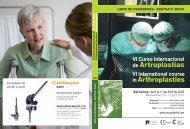cadera / hip - Active Congress.......
cadera / hip - Active Congress.......
cadera / hip - Active Congress.......
You also want an ePaper? Increase the reach of your titles
YUMPU automatically turns print PDFs into web optimized ePapers that Google loves.
MIÉRCOLES / WEDNESDAY<br />
134<br />
TOTAL HIP REPLACEMENT<br />
FOR THE CONGENITAL<br />
DISLOCATED HIP<br />
K. Soballe<br />
Department of Orthopaeadics, Aarhus<br />
University Hospital. Denmark<br />
We have performed 18 total <strong>hip</strong> replacements<br />
due to congenitally dislocated <strong>hip</strong>s using the<br />
Paavoleinen technique with shortening of the<br />
proximal femur and placement o the acetabulat<br />
component in the original acetabulum..<br />
The patients were 9 women and 6 men with<br />
a mean age of 38(16-73). All operations were<br />
performed by the same surgeon (KS).<br />
The patients were all classifi ed as C or D<br />
after the Eftekahrs classifi cation. The follow<br />
up period was from 1 to 9 years.<br />
We had no incident of aseptic loosening and<br />
no infections after primary operation was<br />
encountered.<br />
Three patients underwent reoperation due to<br />
wear of the polyethylene liner There were two<br />
reoperations, one due to early displacement<br />
of the cup and one was open reducted due to<br />
dislocation Two patients experienced dislocation<br />
and were reduced close .Only one patient<br />
experienced temporary peroneal nerve palsy<br />
with complete recurrence after 1 week .<br />
Trendelenburg sign was positive in all patients<br />
preoperatively and only in one postoperatively.<br />
Harris Hip Score regarding pain<br />
on an accumulated basis improved from 81<br />
preoperatively to 28 postoperatively. Likewise<br />
the score for walking ability improved from<br />
63 to 29. .<br />
These intermediate results indicate that the<br />
Paavoleinen operation for the congenital<br />
dislocated <strong>hip</strong> provides the patient with a<br />
stable and functional <strong>hip</strong> with a limited rate of<br />
complications. The number of disloations is<br />
high but comparable with similar publications<br />
on CDH and can be explained by the altered<br />
biomechanicanical situation and the use of<br />
small 22 mm heads. The problem with wear<br />
of the polyethylene liner in younger patients<br />
is still an unsolved issue but hard bearings<br />
might be a solution if available in small sizes<br />
(40-44 mm cup).<br />
ARTHROPLASTIES IN<br />
DYSPLASTIC HIPS<br />
T. Paavilainen<br />
Hospital ORTON, Helsinki, Finland<br />
Introduction. Cementless method created<br />
new possibilities for replacement surgery of<br />
dysplastic <strong>hip</strong>s. Osteotomies of the femur<br />
and the protrusion socket technique became<br />
feasible. In our hospital the operative methods<br />
were developed in 1980’s, already, when<br />
the Lord´s madreporic components were<br />
adopted. Since then the threaded cups were<br />
replaced with the press fi t ones, and more<br />
appropriate stems have been designed and<br />
manufactured by Biomet Inc.<br />
Operative methods. The acetabular component<br />
is seated at anatomic level or even<br />
lower, if the a-p-diameter at that level is too<br />
small for the cup. The protrusion socket<br />
technique is used in cases with thin pelvic<br />
wall to achieve reliable fi xation of the cup to<br />
the host bone.<br />
The level of resection of the femur is estimated<br />
according to the need of lengthening, and<br />
the type and size of the stem is chosen according<br />
to the shape of the femur at the level<br />
of resection. In cases with high dislocation<br />
we have used two techniques. Most favoured<br />
became the method of proximal shortening<br />
of the femur combined with distal advance-





